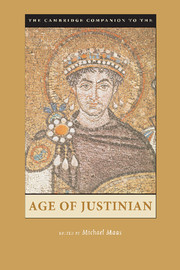Book contents
- Frontmatter
- Part 1 Structures and Ideologies of Empire
- Part 2 Religion and Philosophy
- Part 3 Literature and the Arts
- Part 4 Peoples and Communities
- 16 Jews in the Age of Justinian
- 17 The Age of Justinian
- 18 Justinian and the Barbarian Kingdoms
- 19 Byzantium and the East in the Sixth Century
- 20 The Background to Islam
- Bibliography
- Index
- Plate Section 1
- Plate Section 2
18 - Justinian and the Barbarian Kingdoms
from Part 4 - Peoples and Communities
Published online by Cambridge University Press: 28 May 2006
- Frontmatter
- Part 1 Structures and Ideologies of Empire
- Part 2 Religion and Philosophy
- Part 3 Literature and the Arts
- Part 4 Peoples and Communities
- 16 Jews in the Age of Justinian
- 17 The Age of Justinian
- 18 Justinian and the Barbarian Kingdoms
- 19 Byzantium and the East in the Sixth Century
- 20 The Background to Islam
- Bibliography
- Index
- Plate Section 1
- Plate Section 2
Summary
The Empire and Its Barbarians
In the early summer of 552, the Ostrogothic king Totila faced a large Byzantine army arrayed near Busta Gallorum, in central Italy, for the battle that would decide the fate of his kingdom. He was desperately waiting for reinforcements to arrive. To win time, he rode into the empty space between the two armies, clad in gold-plated armor, with purple adornments hanging from cheek plates, helmet, and spear, and began to perform a war dance. Procopius reports, “He wheeled his horse around in a circle and then turned him again to the other side and so made him run round and round. And as he rode he hurled his javelin into the air and caught it again as it quivered above him, then passed it rapidly from hand to hand, shifting it with consummate skill, and he gloried in his practice in such matters, falling back on his shoulders, spreading his legs and leaning from side to side.” Although the reinforcements arrived, the Goths lost the battle, and Totila died in flight the following night.
Courage, splendor, skill at martial arts, and archaic barbarian customs: Procopius’s famous report reflects a familiar image of the barbarian kings who ruled the West in the time of Justinian. The glory and the fall of these barbarian kings is part of our grand narrative of Justinian’s achievements. His reconquests removed barbarian rulers from some of the former heartlands of the western empire and reestablished direct imperial rule. But by concentrating on the wars against the Vandals, the Ostrogoths, and in some measure also against the Visigoths, Justinian made the empire vulnerable to the attacks by new and more ferocious barbarians: Slavs, Avars, Lombards, Berbers, and others.
- Type
- Chapter
- Information
- The Cambridge Companion to the Age of Justinian , pp. 448 - 476Publisher: Cambridge University PressPrint publication year: 2005
- 6
- Cited by



